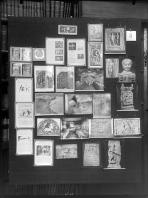In mid-December Warburg and Bing had their first glimpse of the “mithraeum of the seven spheres” in Ostia antica, the port city of ancient Rome (#15.1). Bing recorded in the Tagebuch their fascinated examination of mosaic depictions of zodiacal signs (#15.5) and planetary deities (#15.3) on the benches; they saw, too, the ritual dagger depicted on the floor (#15.2) along with seven arcs (#15.4), which they then took to refer to the seven grades of Mithraic initiation. Soon they absorbed Franz Cumont’s view that the arcs represented the spheres through which the soul ascended; on February 18 Saxl would write to Warburg: “That the seven gates appear on the floor shows best the astral character of the space.”
Warburg’s interest in Mithraism was piqued. On January 1, not long after the Ostian excursion, he asked Ludwig Curtius, director of the German Archaeological Institute in Rome, if any new Mithraic monuments had turned up. Curtius replied: “in Capua and in Dieburg.” Warburg reflected: “the world-spanning range and force of the problem lies in this answer” (Tagebuch). In mid-February he instructed Saxl to send down Friedrich Behn’s new book on the Dieburg mithraeum—and on February 20 he was reading Cumont’s Les mystères de Mithra (1913)—possibly in the 1923 German version, a copy of which exists in the Warburg library with his own bookplate. Cumont’s presence in Rome, where he was attached to the Belgian Academy, doubtless spurred Warburg’s interest in Mithraism: the esteemed historian of ancient religion had more or less single-handedly established the field of Mithraic study with his Textes et monuments figurés relatifs aux mystères de Mithra (1896–99). Warburg pursued Cumont’s acquaintance in Rome and consulted with him from time to time on matters Mithraic.
